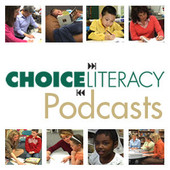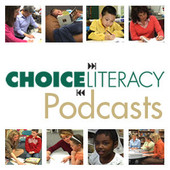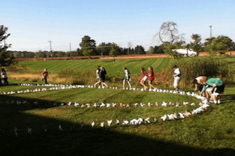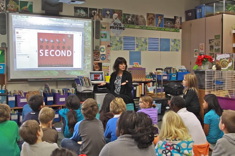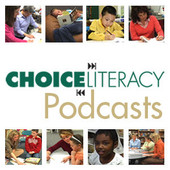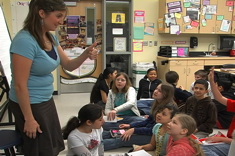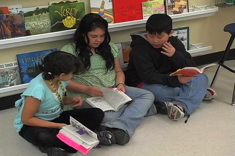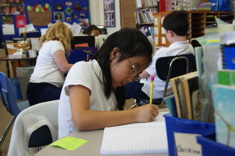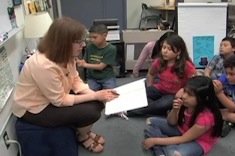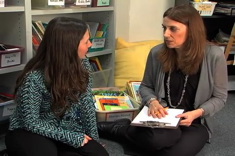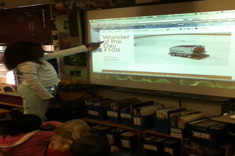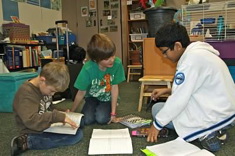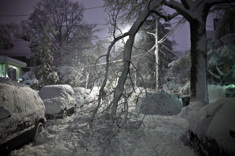Teaching Writing
Everyone who writes for Choice Literacy loves teaching writing, because we all write ourselves. We know it is "hard fun," as Donald Murray famously said—exasperating and exhilarating at the same time. The writing workshops you will read about here and see in our videos are busy, noisy, vibrant places. And most days, we wouldn't want to be anywhere else than in the midst of 'em! Here is where you'll find our latest discoveries, insights, and occasional boneheaded mistakes in teaching writing.
Latest Content
Kate Messner on Revision (PODCAST)
In this podcast, Kate Messner expresses her empathy for how hard revision can be and finds joy in the challenge for all writers.
Writing Celebrations with Ruth Ayres (PODCAST)
Ruth Ayres talks about the importance of writing celebrations, with tips on how to create a festive mood even before students have written anything “fancy” in the classroom.
A Drive Through Assessment of My Writing
While considering some driving habits she's developed, Aimee Buckner shares what she's learned from the experts about writing and what it means to her practice.
When You Hate the Book
Abandoning a text isn't always an option (in school or life). Clare Landrigan considers her own experience as a reader and applies those lessons to the classroom.
Pitching My Lesson Plans for a Day of Peace and Poetry
Seizing an unexpected learning opportunity may be the best way to remember why you became a teacher in the first place. Karen Terlecky celebrates one of these serendipitous moments.
Spelling Rules — Or Does It?
Heather Rader introduces a new spelling series and maps out the topics she’ll be tackling.
Born Wonders: Tapping Student Interest in Animals, Babies, and Books
Cute Alert – what’s more adorable than babies or animals? Perhaps baby animals! Andrea Smith shares an addictive web resource that will instantly hook students of any age. It’s zoo postings of newborn animals from around the world, with many literacy connections.
Refining the Weekly Class Newsletter
Andrea Smith uses the school-to-home communication tool to give her writers an authentic process and audience.
Coaching Reluctant Writers
Heather Rader describes how to use "wows and wonders" to reach students who say they hate to write.
Aimee Buckner on Nonfiction in Student Notebooks (PODCAST)
Aimee Buckner always has notebooks on her mind and we’re glad because she’s upping the nonfiction and modifying for specific learners’ needs. She’ll tell you more in this podcast.
Prewriting is a Party!
Sometimes the most important work for writers takes place before any actual drafting. Heather Rader shows how a simple metaphor can help students understand the importance of planning and organizing drafts.
The Triple Threat: Building a Community, Discussion Skills, and Writing Stamina
Katie Doherty knows how to pick the right text to move from whole-class conversations to writing.
Great Lead Investigators
Katie Doherty turns her middle school students into lead investigators – an activity that is a terrific combination of mentor texts, group work, and connections to student writing.
Off the Beaten Professional Development Path: What I Learned from the Teachers as Writers Group
Teacher writing groups are a wonderful informal way for teachers to get together over the summer voluntarily. Heather Rader has format suggestions, as well as tips for helping your group run smoothly.
Writing Drafts and Stamina
Stamina is a term we use often in literacy instruction, but it can be tricky for students and teachers to define in classroom contexts. Heather Rader looks at the specific attributes of writing stamina, as well as how to model it for students.
Lester Laminack on Reading Like a Writer (PODCAST)
In this podcast, Franki Sibberson chats with Lester Laminack about how he reads as a writer, and what teachers might do to develop this skill in their students. Lester is the author of beloved books for children and teachers, including Saturdays and Teacakes and Unwrapping the Read Aloud
.
Writing Triage: Dealing with Dialogue Disasters
Is there a dialogue doctor in the house? If your students’ writing is filled with dull exchanges, you’ll enjoy these lesson suggestions from Heather Rader.
Fireflies: Then and Now
Andrea Smith watches her young daughter capture fireflies in the twilight of a summer night. The evening reminds her of what’s changed in connecting literacy and life experiences, and what endures for teachers and kids.
Grammar Insecurity: Coaching Editing
By the intermediate grades, many students are fluent writers, but they still need a tremendous amount of help with conventions. Heather Rader writes about how teachers' insecurities about their own skills can get in the way of instruction. She also provides some practical tips for assessing and teaching grammar based on emerging student needs.
Strawberries, Fun, and Student Blogging
Andrea Smith evaluates the success of her new student blogging program.
Graphic Organizer for Mystery Writing
Beth Lawson talks with her 4th graders about the elements of a good mystery, and shares a graphic organizer to help them develop realistic characters and themes.
Writers, Choice and Independence (Part I)
What does true independence look like among young readers and writers? A chance comment from a visitor to Aimee Buckner's classroom gets her pondering the amount of choice children have during units of study.
Transitioning to Guide on the Side: Facilitating Collaborative Scoring
Heather Rader wants to transition to more of a guide-on-the-side role as she coaches colleagues. Here are some simple strategies she uses to move offstage during collaborative scoring workshops.
Wonderopolis: Nonfiction, Technology, and Web-Based Independent Learning
Wonderopolis hits the sweet spot so many of us are looking for in web resources for students, delivering free, engaging, high-quality nonfiction text and video in small chunks that can easily be integrated into literacy and science workshops. Andrea Smith explains how she uses Wonderopolis daily with her students.
Books Struggling Readers Can and Will Want to Read: Building the Classroom Library
Sammy is an avid reader in the classroom, but his teacher Cathy Mere notices he “accidentally” is always leaving the backpack with his intervention books behind. The challenge for classroom teachers is stocking books with titles that will interest Sammy, but still provide enough challenge and support to move him forward as a reader.
Writers, Choice and Independence (Part II)
In this second installment of a two-part series, Aimee Buckner writes about the value of open choice writing units.
An ESL Poetry Cafe Celebration (Part II)
Stella Villalba explains how her Poetry Cafe program brings families together for a festive event, and helps English language learners develop reading and fluency skills at the same time. This is the second installment in a two-part series.
Math Journals
Julie Johnson rekindles her love affair with math when she incorporates journals and sees her students become more adept at organizing and explaining their thinking.
An Uncommon Place
A mulberry tree crashes during a blizzard, creating a surprisingly lovely mental space for Shirl McPhillips to craft her poem.
Injecting Writing into Everything: Cover-up Stories
Cover-up stories involve removing illustrations to heighten awareness of other story elements. Heather Rader explains how the instructional technique works.
Browse Content By
Type
Category
- Assessment Tools
- Big Fresh Archives
- Booklists
- Choice Numeracy
- Classroom Design
- Common Core
- Community Building
- Conferring
- Content Literacy
- Digital Literacy
- English Language Learners
- Equity
- Family Relations
- Free Samples
- Guiding Groups
- Leadership
- Literacy Coaches
- Mentor Texts
- Minilessons
- New Teacher Mentors
- Podcasts
- Poetry
- Quote Collections
- Reading Strategies
- Self Care
- Struggling and Striving Learners
- Talking and Listening
- Teacher Study Groups
- Teaching Reading
- Teaching Writing
- Word Study and Vocabulary
Author
- Melissa Quimby
- Nawal Qarooni
- Gwen Blumberg
- Julie Cox
- The Lead Learners
- Hannah Tills
- Josie Stewart
- Ruth Metcalfe
- Mallory Messenger
- Becca Burk
- Jodie Bailey
- Vivian Chen
- Mary Brower
- Tiffany Abbott Fuller
- Stephanie Affinito
- Ruth Ayres
- Leigh Anne Eck
- Heather Fisher
- Shari Frost
- Julie Johnson
- Suzy Kaback
- Gigi McAllister
- Shirl McPhillips
- Melanie Meehan
- Cathy Mere
- Debbie Miller
- Tara Barnett and Kate Mills
- Tammy Mulligan
- Dana Murphy
- Bitsy Parks
- David Pittman
- Brenda Power
- Heather Rader
- Matt Renwick
- Mandy Robek
- Christy Rush-Levine
- Gretchen Schroeder
- Jen Schwanke
- Brian Sepe
- Katherine Sokolowski
- Stella Villalba
- Jennifer Vincent
Grade Level
Choice Literacy Membership
Articles
Get full access to all Choice Literacy article content
Videos
Get full access to all Choice Literacy video content
Courses
Access Choice Literacy course curriculum and training

